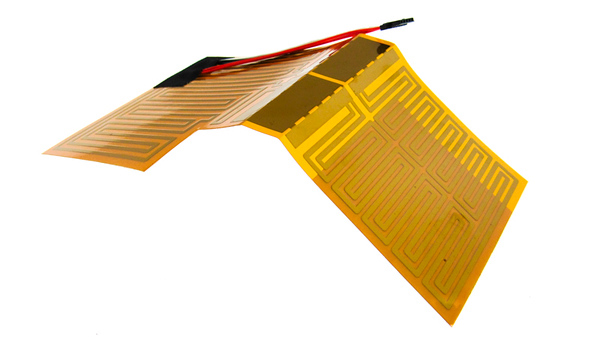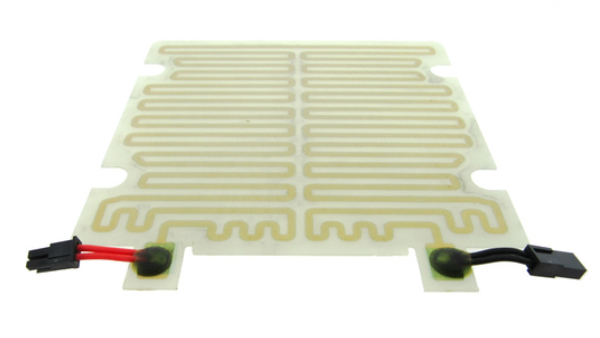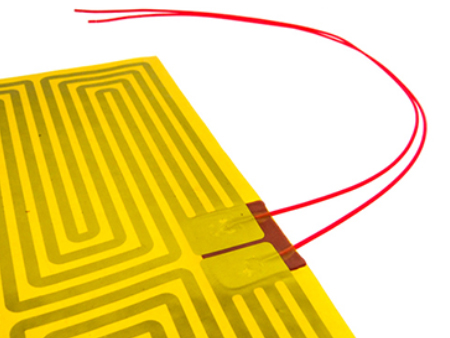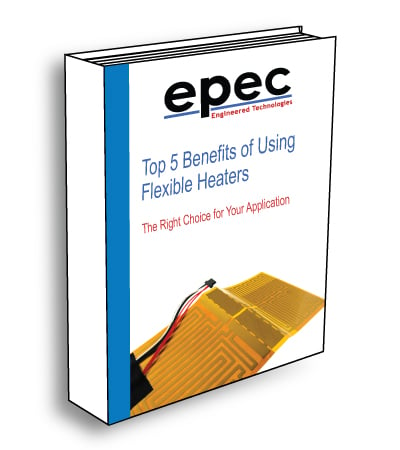What Is A Flexible Heater?
A flexible heater is a chemically etched, screen printed, or wire wound heater which can be flexed or bent to conform to the contours of the surface which requires heating. There are many types of flexible heaters, including silicone rubber heaters (both etched and wire wound), Polyimide/Kapton® Film heaters, carbon printed heaters, and transparent heaters. All of these heaters can come in many different variations which include the ability to customize the size, shape, and thickness along with adding components which can improve the performance of any application.
Flexible heaters are rugged, reliable, accurate, and efficient, and have properties that make them moisture- and chemical-resistant. Since they can be easily bonded or adhered to any type and size of substrate up to and including being actively flexed in an application, flexible heating elements have a wide range of industrial, commercial, and military applications. Flexible heaters are thin, light weight, and are suitable for harsh environments, vacuum applications, and can be operated at temperatures up to 500°F/260°C intermittent and 392°F/200°C continuous.
Efficient and effective heat transfer is the key to being successful in any heating application. Flexible heaters can be adhered directly to the surface that requires heat, which is the most efficient method to ensure that thermal energy transfers out of the heating element. If the heater is designed correctly and installed so that it has a uniform interface between the heater and the substrate to be heated, there is no better mechanism to choose.
Many times, different sensors and controls can be built right into the flexible heater. Pre-set or adjustable thermostats, Thermocouples, Thermistors, RTDs, Thermal fuses, and other electronic components are commonly incorporated as part of designs of our flexible heaters.
Polyimide/Kapton®
Polyimide (Kapton® is a DuPont Trademark for Polyimide) is a thin, lightweight polymer film which provides excellent tensile strength, tear resistance, and dimensional stability. This material has been used for flexible PCBs for over 30 years and when used in a heater application, provides low outgassing in a vacuum along with resistance to radiation, fungus, and many other substances. With the process of using photoimaging technology, the etched foil element will have excellent circuit pattern repeatability which lowers production cost and superior heat transfer. This results from being able to space the elements very close to each other which provides more surface area.

Polyimide Benefits
- Excellent physical and electrical properties result in thermal stability over a wide temperature range.
- Suitable for vacuum environments (NASA-RP-1061) and is a NASA approved material for space applications (S-311-P-079).
- Resistant to most chemicals: oils, solvents, acids and bases.
- Formable, flexible and bondable to Metalwork using a wide range of adhesive options.
- Base materials can be clad with a variety of foil element alloys such as inconel , nickel, copper, nickel-iron and many stainless steels.
- Can provide twice the watt density of wire wound heaters.
Silicone Rubber Heaters
An etched circuit or wire wound heating element is sandwiched between fiberglass-reinforced silicone rubber to give these heaters dimensional stability and efficient heat transfer capability without sacrificing flexibility. In an etched foil design, the internal foil may be identical to that of a polyimide heater, but the silicone rubber provides reliable wear protection from mechanical damage and is more likely to be used in wet environments due to its rugged characteristics.
![]()
Silicone rubber also allows the use of mechanical fasteners which allows a heater to be installed and removed such as: Latch fasteners, Boot hooks, Grommets, Snap Fasteners, Springs and Lacing cord. Additional heat distribution and thermal shielding materials (aluminum and silicone sponge most commonly) can be added to any design to help improve any application.
Silicone Rubber Heater Benefits
- Variety of geometries such as flat, molded-to-shape and spiral wrap.
- Can be used where multiple Watt densities are required.
- Very moisture and chemical resistant.
- Silicone rubber provide best dimensional stability.
- Heaters can be mounted directly to metal through a vulcanizing process using an RTV.
Screen Printed Heaters
Screen printed heaters are produced by screen printing a specific ink on to a flexible substrate such as polyester (PET), polyimide (PI), poly carbonate, and various others. The flexible screen-printed heaters can be produced using an ink that makes the heater capable of self-regulating its temperature or as a fixed resistance heater designs which will need to be regulated through a thermal control circuit. One of the most common uses of these heaters is in the automotive industry where they are used to keep ice from forming on the side view mirrors or cars, busses and trucks.

Screen Printed Heater Benefits
- Low cost to manufacture.
- Less power to operate.
- Uniform heat.
Unlock the Ultimate Flexibility in Heating Solutions!
From conforming to complex surfaces to enduring the harshest environments, our flexible heaters offer unparalleled performance. Whether you require the superior strength of polyimide, the ruggedness of silicone rubber, or the affordability of screen-printed heaters, we have the perfect fit for your needs.
Request a Quote Request Design Support Request More Information



